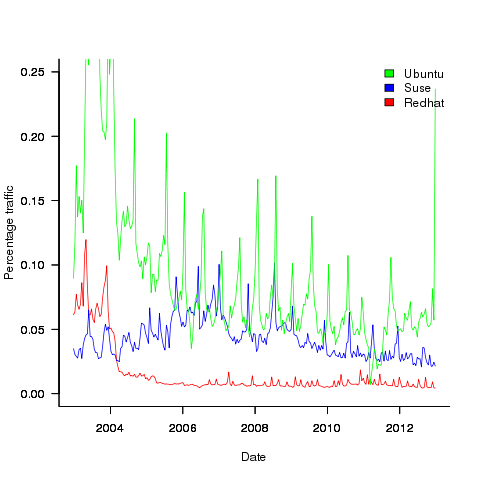Archive
Program fault reports are caused by its users
Faults are generated by users of the software; no users, no fault reports. Fault reports will be generated for software that is free of coding mistakes; one study found that 42.6% of fault reports were misclassified as either requests for an enhancement, changes to documentation, or a refactoring request, or not requiring changes to the code; a study of NASA spaceflight software found that 63% of reports in the defect tracking tool were change requests.
Is the number of reported faults proportional to the number of users, the log of the number of users, or perhaps it depends on the application, or who knows what?
Some users will only use some features, others other features. Some users will be occasional users, while some will be heavy users.
There are a handful of fault report datasets containing measurements of software usage. The largest, and most widely cited, is “Optimizing Preventive Service of Software Products” by E. N. Adams. The data is this paper lists the number of faults reported in eight time intervals (20 to 50,000 months), for nine applications running on IBM mainframes between 1975 and 1980. Traditionally, the licensing for many Mainframe applications charge customers a fee based on their usage. Does this usage data still exist? Perhaps there is some sitting on a shelf in court documents. Pointers to possible cases most welcome.
Early papers on software testing sometimes measured the amount of cpu, or elapsed time, between each fault experience. However, the raw data was rarely published.
Data is available, for the Debian and Ubuntu distributions, on the number of installs for each application (counts rely on local machine sending information on installs, which is now an opt-in process for Ubuntu).
The following analysis uses data from the paper Impact of Installation Counts on Perceived Quality: A Case Study on Debian by Herraiz, Shihab, Nguyen, and Hassan, and the Ubuntu popularity project.
The plot below shows the number of reported faults against number of installs for the 14,565 programs in the “wheezy” Debian release; red line is the fitted power law:  (code+data):
(code+data):

The huge variability in the number of fault reports for a given number of installs is likely driven by variability in the usage of the installed programs (or even no usage; I installed ImageMagick purely to use its convert program), the propensity of users of particular programs to report fault experiences (which in turn depends on the need for a fix, and the ease of reporting), and the number of coding faults in the source code.
The Debian installs/faults data does not include any usage information, however, the Ubuntu popularity data includes not only a count of installs, but the corresponding counts of regular users and non-usages. Given that Ubuntu is a fork of Debian, and has substantial usage, I’m assuming that the user base is sufficiently similar that the Ubuntu usage data at the time of the “wheezy” release can be applied to the “wheezy” Debian install/fault data.
The plot below shows, for 220,309 programs, the fraction of installs that are regularly used against the corresponding number of installs. The left-most line running top-left to bottom-right shows programs regularly used by one install, next line two regular users, etc (code+data):

Using the merged, by program name, Ubuntu usage/Debian fault counts, I built several regression models, along with plotting the data/fits. The quality of the models was worse than the original Debian model 🙁 . Two possibilities that spring to mind are: the correlation between usage and fault reports only becomes visible when the counts are divided into short periods (perhaps a year?), or the correlation is very weak. It is probably going to take a lot of time to work through this.
Research ideas for 2023/2024
Students sometimes ask me for suggestions of interesting research problems in software engineering. A summary of my two recurring suggestions, for this year, appears below; 2016/2017 and 2019/2020 versions.
How many active users does a program or application have?
The greater the number of users, the greater the number of reported faults. Estimates of program reliability have to include volume of usage as an integral part of the calculation.
Non-trivial amounts of public data on program usage is non-existent (in a few commercial environments, users are charged for using software on a per-usage basis, but this data is confidential). Usage has to be estimated by indirect means.
A popular indirect technique for estimating the popularity of Github repos is to count the number of stars it has; however, stars have a variety of interpretations. The extent to which Github stars tracks usage of the repo’s software is not known.
Other indirect techniques include: web server logs, installs of the application, or the operating system.
One technique that has not yet been researched is to make use of the identity of those reporting faults. A parallel can be drawn with the fish population in lakes, which is not directly visible. Ecologists have developed techniques for indirectly estimating the population size of distinct creatures using information about a subset of the population, and some of the population models developed for ecology can be adapted to estimating program user populations.
Estimates of population size can be obtained by plugging information on the number of different people reporting faults, and the number of reports from the same person into these models. This approach is not as easy as it sounds because sometimes the same person has multiple identities, reported faults also need to be deduplicated and cleaned (30-40% of reports have been found to be requests for enhancements).
Nested if-statement execution
As if-statement nesting depth increases, the number of conditions controlling the execution of the enclosed code increases.
Being able to estimate the likelihood of executing the code controlled by an if-statement is of interest to: compilers wanting to target optimizations along the most frequently executed paths, special handling for error paths, testing along the least/most likely paths (e.g., fuzzers wanting to know the conditions needed to reach a given block), those wanting to organize code for ease of understanding, by reducing cognitive effort to understand.
Possible techniques for analysing the likelihood of executing code controlled by one or more nested if-statements include:
- Compiler writers have discovered various heuristics for predicting the likely outcome of a branch, and there are probably more to be discovered. Statement coverage counts provides a ground truth against which to compare ideas,
- analysis of the conditional expression,
- mathematical analysis of the distribution of values of variables in conditional expressions.
O Cobol, Cobol! wherefore art thou Cobol?
Programming language popularity has been in the news again and as always Cobol is nowhere to be seen in the rankings. Even back in the day, when people in the know generally considered Cobol to be the most widely used language it often failed to appear, or appeared very low down, in language rankings. I think Cobol’s unrepresentative rankings occur because users of Cobol are assumed to hang out in the same places as users of other programming languages. The letters bo in the name is the clue, business oriented people are not usually interested in technical stuff and tend not to read the magazines (and these days web sites) that users of the other popular languages read.
Cobol is very business domain specific and does not contain functionality that makes it a reasonable choice for writing applications in other domains (it is possible to write a compiler in Cobol, for instance the Micro Focus compiler is written in Cobol). It has very sophisticated languages constructs for handling data having the most convoluted formats imaginable, essential in the business world which has to process data whose format has evolved over the years into a tangled mess (developers have to deal with spaghetti code, business has to deal with spaghetti data formats). Cobol’s control flow and code structuring facilities are primitive (all variables are global and the perform statement is very similar to the gosub statement found in Basic’s that are line number based) because business data processing tends to be relatively simple and programs to handle them are generally small (the large Cobol programs of legend are invariably made up of lots of small programs run in series with complicated data format dependencies between them).
I started to realise just how different Cobol is when working on my first Cobol code generator (yes it was written in Cobol). If a processor has lots of registers it is usually worthwhile to dedicate one to holding the value zero (of the 32 registers supported by most RISC processors, often only 31 can hold different values, one is dedicated to returning zero when read from and ignores any value written to it), in the case of Cobol it is considered worthwhile to dedicate a register to hold 0x20202020 (four space characters) rather than zero.
Is Cobol still the most widely used language today? No, I don’t think so. Business people love spreadsheets which means developers have switched to writing pre/post data format processing code, previously in Cobol, in Visual Basic (to convert input data into a form accepted by the spreadsheet and then print the results of the spreadsheet calculations in a presentable format); this Visual Basic source can often have a Cobol-like feel to it. This spreadsheet usage also resulted in the comma separated list becoming a widely used format for data representation, eroding Cobol’s unique selling point of sophisticated input/output data format processing.
What does language popularity mean? Does using a language you don’t like count towards it being popular? There are several languages I like and very rarely get to use, does this mean I don’t get to contribute to their popularity?
In these tough financial times the number of job adverts requiring knowledge of a specified language is probably of more interest than number of posts to web sites. One job search site lists 3,032 Cobol jobs and counting job ad hits for the top languages listed in a recent popularity poll puts Cobol at the bottom end of the cluster of highest ranked languages.
On mainframes I think Cobol is likely to still be No. 1; it is probably impossible to replace the dominant language in a niche market.
 %, would not have passed).
%, would not have passed).
Recent Comments